Categories
Left column house ads
Cooking Like Aarón Sánchez
February 21, 2012 Restaurant/Bar News
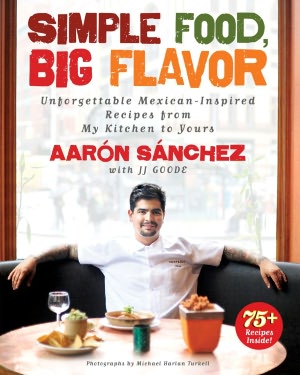 On Saturday night, Adam and I decided to cook dinner from Simple Food, Big Flavor: Unforgettable Mexican-Inspired Dishes from My Kitchen to Yours, the new cookbook by Aarón Sánchez, the chef at Centrico. I should say that I decided we’d be cooking dinner from Aarón Sánchez’s book. If it were up to Adam, we’d exclusively rely on Suzanne Goin’s Sunday Suppers at Lucques, which might as well be called Complex Food, Subtle Flavor: My Kitchen Has a Crew of Dishwashers and Yours Doesn’t.
On Saturday night, Adam and I decided to cook dinner from Simple Food, Big Flavor: Unforgettable Mexican-Inspired Dishes from My Kitchen to Yours, the new cookbook by Aarón Sánchez, the chef at Centrico. I should say that I decided we’d be cooking dinner from Aarón Sánchez’s book. If it were up to Adam, we’d exclusively rely on Suzanne Goin’s Sunday Suppers at Lucques, which might as well be called Complex Food, Subtle Flavor: My Kitchen Has a Crew of Dishwashers and Yours Doesn’t.
The Menu
Sánchez is a TV chef (“Heat Seekers” and “Chopped”), so I went into the book expecting it to be somewhat dumbed down, and while it wasn’t Sandra Lee, Queen of the Half-Baked or whatever her claim to fame is, it felt pretty ghostwritten. Maybe Sánchez really says things like, “Your food will go from inspiring smiles and polite nods to igniting ridiculous grins and bear hugs,” but I hope not. Then again, not even I buy a cookbook for the introduction, and the proof would be in the recipes.
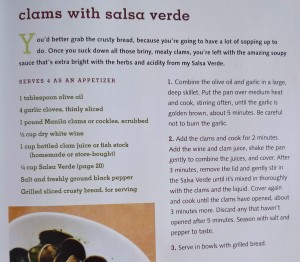
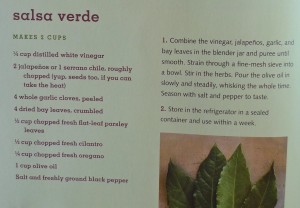 I flipped through it on Friday afternoon. There are 15 core recipes for “sauces, purees, and pastes that you can keep in the fridge or freezer and pull out whenever you want to turn a simple collection of ingredients into a seriously tasty dinner.” Each of those is followed by recipes that use the sauce, puree, or paste. I was tempted to make the first core recipe, Garlic-Chipotle Love, despite the name and despite the caution that “garlic is like a good woman.” (There’s more to that nugget of wisdom but if I start typing it I’ll be too tempted to substitute shockingly offensive replacement text.) The book has a recipe for mussels that incorporates Garlic-Chipotle Love, and mussels are on the list of Jonathan Safran Foer–approved edible animals, but I couldn’t get excited about it. That could be because the next main recipe, Salsa Verde, includes twice as much cilantro, and I l-u-v cilantro. I can’t pass by a bunch without sticking my face in it. So I went with Clams with Salsa Verde; we’ve been having a lot of clams (also JSF-approved) lately, so I figured we’d be able to compare the dish to others.
I flipped through it on Friday afternoon. There are 15 core recipes for “sauces, purees, and pastes that you can keep in the fridge or freezer and pull out whenever you want to turn a simple collection of ingredients into a seriously tasty dinner.” Each of those is followed by recipes that use the sauce, puree, or paste. I was tempted to make the first core recipe, Garlic-Chipotle Love, despite the name and despite the caution that “garlic is like a good woman.” (There’s more to that nugget of wisdom but if I start typing it I’ll be too tempted to substitute shockingly offensive replacement text.) The book has a recipe for mussels that incorporates Garlic-Chipotle Love, and mussels are on the list of Jonathan Safran Foer–approved edible animals, but I couldn’t get excited about it. That could be because the next main recipe, Salsa Verde, includes twice as much cilantro, and I l-u-v cilantro. I can’t pass by a bunch without sticking my face in it. So I went with Clams with Salsa Verde; we’ve been having a lot of clams (also JSF-approved) lately, so I figured we’d be able to compare the dish to others.
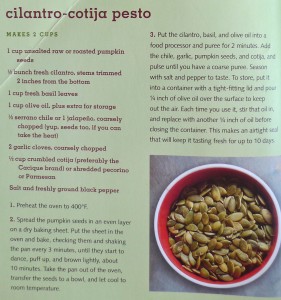
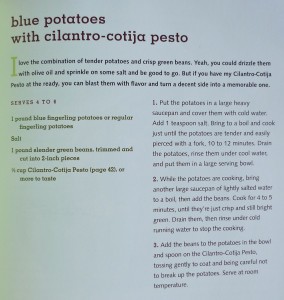 At times, I felt like I was reading a cookbook written by a five-year-old in that stage where they have to claim everything as their own. Other core recipes included Aarón’s Adobo; Aarón’s Chorizo (!); Aarón’s Achiote Paste; Pickled Onions, My Way; and Mole, My Way. Perhaps Sánchez feels this sort of thing is necessary in order to get out of the shadow of his mother, Zarela Martinez, but still.
At times, I felt like I was reading a cookbook written by a five-year-old in that stage where they have to claim everything as their own. Other core recipes included Aarón’s Adobo; Aarón’s Chorizo (!); Aarón’s Achiote Paste; Pickled Onions, My Way; and Mole, My Way. Perhaps Sánchez feels this sort of thing is necessary in order to get out of the shadow of his mother, Zarela Martinez, but still.
I signed us up for the Blue Potatoes with Cilantro-Cotija Pesto, unable to resist the siren call of “1/2 bunch” of cilantro.
Some of the core recipes sounded delicious—Roasted Tomato–Chile de Árbol Salsa, Habanero Love (I think “Love” is a Sánchez family stand-in for “sauce”), Roasted Tomatillo Salsa (I tried locating tomatillos once and vowed never again). A little concerned that Adam would think I only chose recipes based on the amount of cilantro, I landed on Tangerine and Jicama Slaw with Chicharrón, which used Mango–Aji Amarillo Puree in the dressing. Adam loves mangoes! And as the salad chef in my household, I’m always looking for salads that don’t involve the same old ingredients and vinaigrettes. Plus, cilantro was only a garnish, which barely counts. To review, we’d be having:

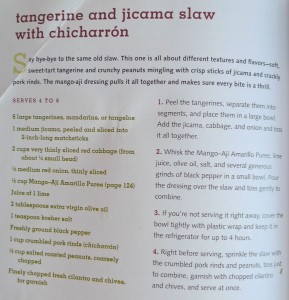 • Clams with Salsa Verde
• Clams with Salsa Verde
• Blue Potatoes with Cilantro-Cotija Pesto
• Tangerine and Jicama Slaw (without the chicharrón, or pork rinds)
The Sourcing
I was so fond of how festive the ingredients looked on the Whole Foods check-out belt that I took a photograph: red cabbage, tangerines, limes, jicama, all that cilantro…. (The Sweet Action beer and blood oranges were for general consumption.) And as someone who has always been slightly appalled by the idea of clam juice, I got a perverse thrill out of buying it; did the person behind me think I was more interesting as a result of it? (Or did simply she think I was a wackadoodle for taking a photo of my purchases?) We’ll never know…..
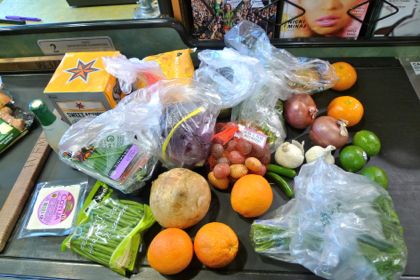 Alas, neither Whole Foods nor the Food Emporium, Dean & Deluca, Gourmet Garage, or Morgan’s had mango puree. Sánchez (or someone) wrote that it’s “sold fresh and frozen just about everywhere,” so I guess he doesn’t live downtown. The stores didn’t have aji amarillo paste, either, and I didn’t have time to go to Kalustyan’s for Sánchez’s favorite brand. He says you can sub in an overripe mango, but I can never even find a ripe mango, let alone an overripe one. We’d have to get creative.
Alas, neither Whole Foods nor the Food Emporium, Dean & Deluca, Gourmet Garage, or Morgan’s had mango puree. Sánchez (or someone) wrote that it’s “sold fresh and frozen just about everywhere,” so I guess he doesn’t live downtown. The stores didn’t have aji amarillo paste, either, and I didn’t have time to go to Kalustyan’s for Sánchez’s favorite brand. He says you can sub in an overripe mango, but I can never even find a ripe mango, let alone an overripe one. We’d have to get creative.
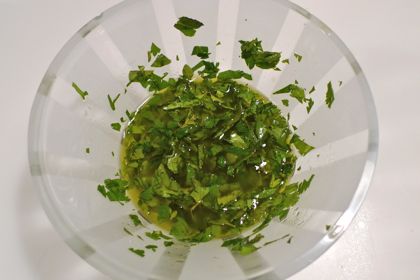 The Cooking
The Cooking
What I hadn’t told Adam when I ran the courses by him was that we were actually cooking six recipes, because each of the dishes involved one of those core sauces, purees, or pastes. Consequently, there was much grumbling by a certain co-chef. I reminded him that he likes complex cooking, but he said this wasn’t actually complex, it was just a lot of chopping.
First Adam made the Salsa Verde (pictured above), which includes chile peppers, garlic, bay leaves, parsley, cilantro, and oregano. It didn’t go quite as planned because Whole Foods mislabeled the chiles, and I bought serranos instead of jalapeños—and also because Adam used the whole serrano, seeds included, even though Sánchez warns that it’ll be much hotter that way. It was—so much so that Adam complained that his eyes were burning and insisted that the pug would have to eat later lest his dinner get contaminated by serrano oil. (I ignored that.) I thought the Salsa Verde was delicious on its own, even if the cilantro was overwhelmed by the peppers. The clams themselves involved an interesting preparation: You cook garlic in a tablespoon olive oil, then add the clams for two minutes—and only then do you add clam juice and white wine, and then the salsa verde.
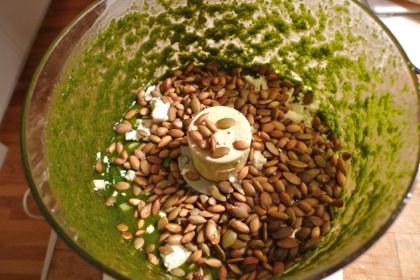
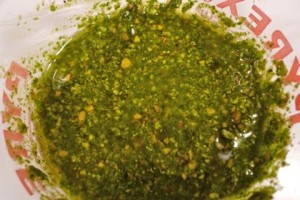 The Cilantro-Cotija Pesto was easy. The pumpkin seeds had to be toasted, but the beauty of pesto is that the food processor does most of the chopping. So in went the cilantro, basil, and olive oil, followed by serrano chile, garlic, pumpkin seeds, and cotija cheese. I managed two spoonfuls before I was told to back away from the Cuisinart. The potatoes had to be boiled, as did the haricots verts, and not in the same water/pot.
The Cilantro-Cotija Pesto was easy. The pumpkin seeds had to be toasted, but the beauty of pesto is that the food processor does most of the chopping. So in went the cilantro, basil, and olive oil, followed by serrano chile, garlic, pumpkin seeds, and cotija cheese. I managed two spoonfuls before I was told to back away from the Cuisinart. The potatoes had to be boiled, as did the haricots verts, and not in the same water/pot.
None of the above required much creativity. For the Mango-Aji Amarillo Puree, however, we had to develop workarounds. I had bought frozen mango chunks as a backup, letting a half cup defrost in the fridge all day. I pureed them in our small food processor, which seemed to work out. I added the requisite mustard, honey, and lime zest and lime juice, and then instead of aji amarillo, I tossed in a pinch of chile de árbol powder. It wouldn’t be quite the same as aji amarillo (which “has a lovely heat that doesn’t explode onto your tongue, but rather slowly builds to a pleasant heat, like sitting on a field on a summer day”), but as they say in Mexico City, whatever. It tasted fine, if a tad fishy, but then I find mangoes can go that way.
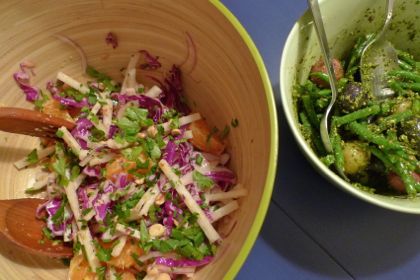 The rest of the slaw was about peeling, chopping, slicing, juicing, and in the case of the tangerines, removing seeds. As I fiddled with the segments, I cursed at the photo in the book, which shows the citrus segments with the pith removed, even though the recipe doesn’t say to do that—setting you up for a disappointing comparison.
The rest of the slaw was about peeling, chopping, slicing, juicing, and in the case of the tangerines, removing seeds. As I fiddled with the segments, I cursed at the photo in the book, which shows the citrus segments with the pith removed, even though the recipe doesn’t say to do that—setting you up for a disappointing comparison.
The Bottom Line
The thing about vegetarian food (or even mostly vegetarian food) is that if you want the flavors to be sophisticated, you have to do twice as much prep work as when there’s meat—so we really shouldn’t have been surprised to have used two food processors, a blender, every one of our good knives, three pots, and at least three cutting boards. But the book was straightforwardly written and we had no confusion, although the direction to use the “juice of 1 lime” made me wonder if the writers had ever spent much times with limes. In my years of extensive gin-and-tonic research, I’ve learned that the juiciness of limes can vary widely.
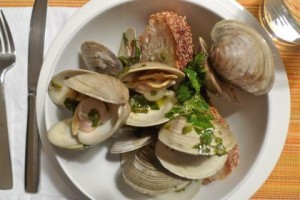 And the food was all quite good! The Salsa Verde was a keeper, and if the overall clam dish wasn’t as rich as Suzanne Goin’s, what is? The Salsa Verde gave the shellfish a wonderful heat, and the wine broth was so tasty soaked into a piece of Grandaisy sesame bread. The real winner was the Cilantro-Cotija Pesto, which tasted like a traditional basil pesto but more interesting (and possibly a better value because you don’t have to buy pine nuts). We weren’t sure that potatoes and green beans were the best match for it—I know it’s a traditional way to use pesto, but I find the beans take too much control of the dish. We made extra pesto, so we’ll try it on a pasta. And even if we don’t make the salad again, we enjoyed having the different flavors—a bit Mexican, a bit Thai (thanks to the peanuts). The book successfully knocked us out of our comfort zone, and what’s more, it was a very healthy meal. As I said to Adam midway through, “There’s no butter in this dinner, is there?”
And the food was all quite good! The Salsa Verde was a keeper, and if the overall clam dish wasn’t as rich as Suzanne Goin’s, what is? The Salsa Verde gave the shellfish a wonderful heat, and the wine broth was so tasty soaked into a piece of Grandaisy sesame bread. The real winner was the Cilantro-Cotija Pesto, which tasted like a traditional basil pesto but more interesting (and possibly a better value because you don’t have to buy pine nuts). We weren’t sure that potatoes and green beans were the best match for it—I know it’s a traditional way to use pesto, but I find the beans take too much control of the dish. We made extra pesto, so we’ll try it on a pasta. And even if we don’t make the salad again, we enjoyed having the different flavors—a bit Mexican, a bit Thai (thanks to the peanuts). The book successfully knocked us out of our comfort zone, and what’s more, it was a very healthy meal. As I said to Adam midway through, “There’s no butter in this dinner, is there?”
“Don’t remind me.”
A Few Last Thoughts
• The next step in my food-photography evolution will be to take photos that don’t involve circles.
• When attempting to cook more than one recipe from the same book simultaneously, make a copy of the recipes so you don’t have to flip back and forth.
• You can buy Simple Food, Big Flavor online or at Barnes & Noble, and I’m sure Centrico is selling it. The retail price is $27.
More articles like this:
••• Cooking Like Kurt Gutenbrunner
••• Cooking Like Andrew Carmellini
2 Comments
Subscribe
Subscribe to the TC Newsletter
















Contrary to most Americans’ (East Coast anyway) idea of Mexican food, it is really very complex. A look through any of Diana Kennedy’s books such as “The Cuisines of Mexico”, Harper & Row, 1972, is a good introduction to the regional foods and its elaborate preparation.. And, this is without Cuisianarts!
“it felt pretty ghostwritten” Um, did you look at the cover? The AU bios at the back? You might be hardpressed to find a chef’s cookbook that *isn’t* ghostwritten. At least Aaron says so (literally) up front. I don’t know Aaron, but I do know JJ, and I’d bet that he captured Aaron’s schtick, I mean essence. Can if be offensive sometimes? Yeah, but so what? The food is good!
I will admit to having a soft spot for this book: I copy edited it. So if you find real errors, let me know. But don’t blame me for the photos not matching the recipes–checking that came after I worked on it, and if I’d had to do that, I would definitely have noticed and bitched about it. (FYI: the books “by” Mario Batali that I’ve proofed are egregious in their disconnect between the recipes and the photos.)
Finally, if I may, there is an old (and rather long) joke in cookbook circles. It doesn’t fully apply here, but I can’t resist:
A home cook calls an experienced cookbook author whose cookbook she has recently bought. Home Cook is spitting mad when she calls the Cookbook Author (whose number is listed, and who answers her own phone):
HC: I just bought your cookbook and made the recipe for apple pie and it was awful! It tasted terrible, the crust was pasty and gross on the bottom and burnt on top, and the filling got all mushy and tasted disgusting! Horrible!!!
CA: Oh, I’m so sorry that you didn’t like it. I worked very hard on that recipe and tested it a dozen times. Did you follow it precisely?
HC: Yes, I did. Of course I did! You think I don’t know how to read?
CA: Oh, no, I didn’t mean to imply that. Maybe I can help you figure out what went wrong. The crust called for pastry flour, butter, salt, and water. What kind of flour did you use? And salted or unsalted butter?
HC: Well, I only had a little bit of regular flour, and couldn’t leave the house to go to the store, so I used mostly cornstarch. I couldn’t leave because the plumber was fixing the kitchen sink, so the water was off, so I used some beer instead of water. I wouldn’t dream of having awful fatty butter in the house, so I added some cooking oil I used to fry fish a few weeks ago. And I only had garlic salt so that’s what I used. But I measured everything just like you said—I used my coffee mug to measure the 2 cups of flour, and my wooden spoon to measure the 5 tablespoons of oil. I have this big wooden spoon I use all the time. I’m really a very good cook, and that’s why I’m so upset about your recipe being so bad. And my family likes food with some flavor, so instead of the pinch of salt you called for, I added a whole spoonful.
CA: I see . . . and you let the dough rest in the refrigerator for an hour before you rolled it?
HC: Who had an extra hour? I had to get dinner on the table! And anyway, that dough just oozed all over the counter. It made a real mess for me to clean up.
CA: I’m sorry, really. . . . What about the filling of apples, raisins, sugar, cinnamon, and lemon juice and zest?
HC: Well, the only fruit I had in the house was bananas. I was a little surprised that you didn’t say to peel them, but I figured you’re the expert. Boy, was I wrong! But I guess I used the amount of Raisinets you said. I’m trying to lose weight, so instead of the half-cup of sugar I used a half-cup of Equal. Same difference. My kids don’t like those weird spices so I used something familiar—chili powder, I think. And I gotta tell you, you are so out of touch with your readers—lemons aren’t cheap! So I just left the juice out. And the only Zest I know is soap, and I sure wasn’t going to put soap in my pie. You must be crazy!
CA: Um, yes, in that case you were right to leave out the lemon juice and zest. What about the pie dish? Did you use a 9-inch glass pie dish as I said?
HC: Oh, you cookbook writers must think we live in mansions like you and have all kinds of fancy stuff in our kitchens. As if! But actually, yeah, I used a glass dish, one my mother used to hang on the wall; it’s really pretty, with a picture of angels painted on it. I thought it was a kinda strange, ’cause I would’ve thought that you’d bake a pie in something with sides that come up, but you’re the boss and you said a glass dish! I don’t know if it’s 9 inches; the kids were using the ruler to do their homework. But it looked about that big to me; anyway, it was about the same size as the plates I wanted to to use to serve that pie on. But I couldn’t serve it! It was horrible!! I’m so mad and it’s all your fault.
CA: Really, I am very sorry that you didn’t like the pie. One last question: did you bake it at 425 degrees for an hour and a half? It has so much fruit in the filling, it really needs to bake that long.
HC: You think I’m going to use that much gas just for a pie?! So I put it in the toaster oven, and I gotta tell you, it was a big mess to clean up when the dish broke. You writers with your big kitchen staffs of slaves just don’t care how much work you make for us!
CA: There were instructions for baking the pie in a toaster oven. If you followed them—
HC: Well, I guess it would’ve been worse if I hadn’t put it on the baking tray first, like you said. I did everything you said and the pie was awful. You embarrassed me in front of my family. You shouldn’t be getting all that money for writing such terrible stuff. I’m never going to buy one of your books again, and I’ll tell all my friends not to, either.
CA: I’m sorry you feel that way. But thank you for calling and letting me know what was wrong with the recipe. That’s a big help to me. Bye now!